

Louisiana

The Smile Says It All
Ski-Dawgs offers the joy of waterskiing to those who may otherwise not have the opportunity Page 20




Country

Alissa Nootz waves as she takes her turn on the water. PHOTO COURTESY OF DAVID THOMAS











Move Over to Protect Roadside Crews
Perched in a bucket truck repairing power lines along a busy road, lineworkers have good reason to be concerned about their safety. However, most aren’t apprehensive about falling or working with high-voltage lines. Their biggest worry is the most unpredictable—distracted drivers.
The National Safety Council reports that 891 people were killed and 37,701 were injured in work zone crashes during 2022, in the most recent statistics available. Most crashes occurred at well-marked construction sites. Electric co-op crews can face even greater danger, as they work alone on remote roads, often in heavy rain or weather conditions that reduce visibility.
This danger led every state to adopt “move-over laws” requiring drivers to slow down and switch lanes whenever possible to protect emergency vehicles. The goal is to provide a safety buffer and minimize the potential for accidents. Drivers caught violating the law can face penalties, including significant fines.
Unfortunately, the Journal of Road Safety reports that only 14 states’ moveover laws protect construction trucks and utility vehicles. That means drivers in those states are under no legal obligation to give lineworkers that added margin of safety.
Compounding this issue is the dramatic
increase in distracted driving. The National Transportation Highway Safety Administration reports that as many as 1,000 Americans are injured each day because of activities that take drivers’ attention away from the road. The most common is reading and responding to text messages. If a driver traveling at 55 mph glances at the phone for five seconds, the car travels the length of a football field before the driver’s attention returns to the road.
The design of today’s vehicles contributes to distractions. Many vehicles have complex controls for entertainment and climate that demand the driver look away from the road to make adjustments.
Geography can also be a factor. Co-ops serving rural and remote areas often have power lines along twisty and hilly roads. Locals accustomed to driving those roads at fairly high speeds may be startled and have little time to react when they encounter a work crew past a hill or around a curve.
Besides the potential for lineworker injuries, accidents can also damage or destroy expensive service vehicles, reducing a co-op’s ability to respond to outages and other problems. Power poles and other infrastructure may also suffer severe damage.
Additionally, tasks performed by lineworkers, such as reconnecting
Association of Louisiana Electric Cooperatives Inc.
Staff
COMMUNICATIONS COORDINATOR Conley Bourgeois
MEMBER ENGAGEMENT COORDINATOR Rhianna Garon
ACCOUNTING MANAGER Beth Fraser
CREDIT UNION REPRESENTATIVE Jody Overhultz
Board of Directors
President Michael Heinen
Vice President Roger Dale DeHart
Secretary/Treasurer Richard Sitman



ALEC Members
BEAUREGARD ELECTRIC COOPERATIVE INC.
Mike Viator
CLAIBORNE ELECTRIC COOPERATIVE INC.
Mike Marcotte Lane Davidson DEMCO
Daniel Berthelot Richard “Dickie” Sitman
JEFF DAVIS ELECTRIC COOPERATIVE INC.
Michael Heinen Byron Hardee
SOUTH LOUISIANA ELECTRIC COOP ASSOCIATION
Trevor Benoit Roger Dale DeHart
WASHINGTONST. TAMMANY ELECTRIC COOP INC.
Joe Jarrell Dennis Glass
Associate Member

high-voltage power lines, are inherently dangerous and require their complete attention and focus. When distracted by speeding or noisy vehicles, they’re more likely to make mistakes that can complicate the repair or cause injury.
Co-op employees are not at risk only when their vehicles are parked and repairs are underway. Lineworkers often have to drive slowly along the shoulders of roads to pinpoint broken power lines or failed transformers, especially in darkness or limited-visibility conditions.
Many state transportation agencies have work zone awareness programs. Amplifying those efforts by devoting part of a co-op’s advertising, publicity and social media reminds co-op members and other drivers of the importance of giving lineworkers a wide berth.
Co-ops are exploring ways to modify bucket trucks and other service vehicles to increase their visibility. Bright colors and additional lighting, such as flashing strobe lights and lighted detour arrows, can attract attention from a distance. Reflective “work zone ahead” signs can also alert drivers to be ready for an unusual situation. Sometimes, just a little extra attention is all that’s needed to prevent a serious accident.


WASHINGTONST. TAMMANY ELECTRIC OFFICES
Main office
950 Pearl St. (P.O. Box 697)
Franklinton, LA 70438
Phone: 985-839-3562
www.wste.coop
Additional offices
21504 Mire Drive
Abita Springs, LA 70420
13526 Hwy. 40 Folsom, LA 70437
2081 E. Gause Blvd.
Slidell, LA 70459
GENERAL MANAGER
Dane Hocott
BOARD OF DIRECTORS
Dr. Francis Cefalu | President
Dennis Glass | Vice President
Olander Smith | Secretary
Glenn Magee | Treasurer
Joe Jarrell Jr.
Chris Graves
Billy Wayne Rester
Charles Singletary
Nickey Smith
Volume 42, Issue 3
Louisiana Country (USPS 473-180) is published bimonthly by the Association of Louisiana Electric Co-ops Inc., 10725 Airline Hwy., Baton Rouge, LA 70816, in partnership with Pioneer Utility Resources.
Annual subscriptions: Members $2.59. Nonmembers $5.
Postmaster: Send form 3579 to 10725 Airline Hwy., Baton Rouge, LA 70816.
Periodicals postage paid at Baton Rouge, Louisiana 70821, and additional mailing offices.
Beyond the Bill
The power of Smarthub
Life can be hectic.
But you can be on the go and in control, managing your electric utility account like never before. The true power of SmartHub goes far beyond the bill.
Did you know SmartHub can help you manage your account with easy features? Whether through a PC, your smartphone or tablet, you’ll be able to pay your bill, view your use, report an outage and more. This free app can make your life easier.
As soon as you log in, you’ll be able to view your billing history and make a payment with just a couple of clicks. (Account No. 90892900)
You’re also able to see your current bill or previous bills if you want to compare costs. Not only will you see your billing history, but you’ll be able to view your actual use. Seeing how your use trends over time will allow you to take steps to lower your costs.
You are just a click away from reporting an outage, since reporting a service issue is a snap with the SmartHub mobile app. There’s no need to call the office, just let us know about the issue with a few clicks.
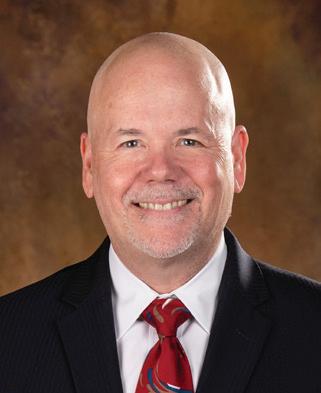

Upcoming 2025 Office Closures
FRIDAY, APRIL 18 ....................................................................................... GOOD FRIDAY
MONDAY, MAY 26
FRIDAY, JULY 4 .............................................................................. INDEPENDENCE DAY
MONDAY, SEPT. 1 LABOR DAY
The Lucky Account Number Contest continues this month with two winners included in this edition of Louisiana Country. Before you look through this edition for your winning number, find your account number printed above your mailing address. Spot that number anywhere in this issue and win $50. To claim your prize, call 985-839-3562.


Dane Hocott
Powering Up After an Outage
When the power goes out, we expect it to be restored within a few hours. But when a major storm or natural disaster causes widespread damage, extended outages may result. Our line crews work long, hard hours to restore service safely to the greatest number of consumers i n the shortest time possible. Here's what's going o n if you find yourself i n the dark:

1. High-Voltage T rans mission Lines:
Transmission towers and cables that supply power to transmission substations (and thousands of members) rarely fail. But when damaged, these facilities must be repaired before other parts of the system can operate.
2. Distribution Substation:
A substation can serve hundreds or thousands of consumers. When a major outage occurs, line crews inspect substations to determine if problems stem from transmission lines feeding into the substation, the substation itself or if problems exist further down the line.
If the problem cannot be isolated at a distribution substation, distribution lines are checked. These lines carry power t o large groups of consumers in communities or housing developments.
4. Tap Lines:
If local outages persist, supply lines (also known as tap lines) are inspected. These lines deliver power to transformers, either mounted on poles or placed on pads for underground service, outside businesses, schools and homes.
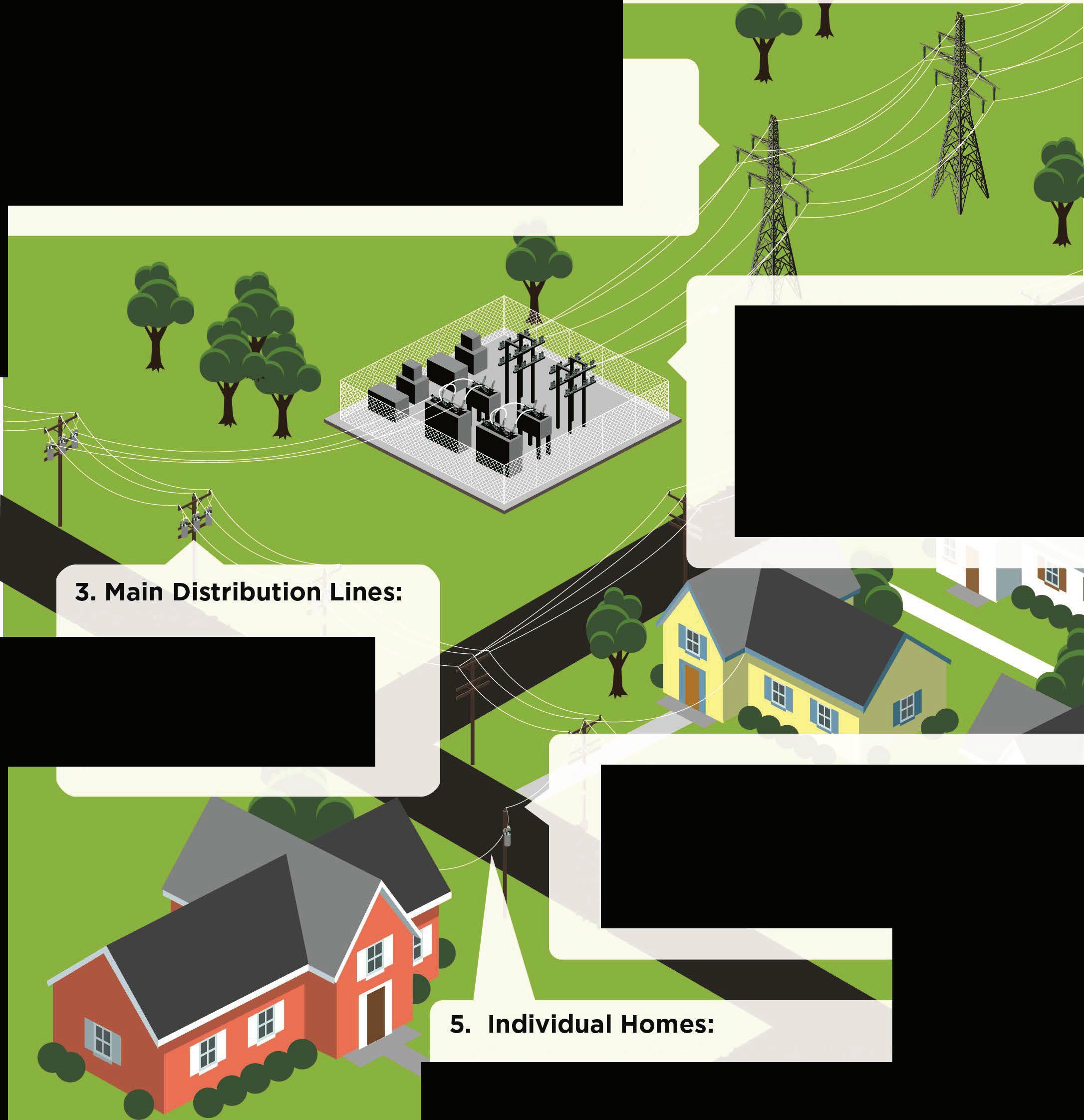
If your home remains without power, the service line between a transformer and your residence may need to be repaired Always call to report an outage to help line crews isolate local issue.



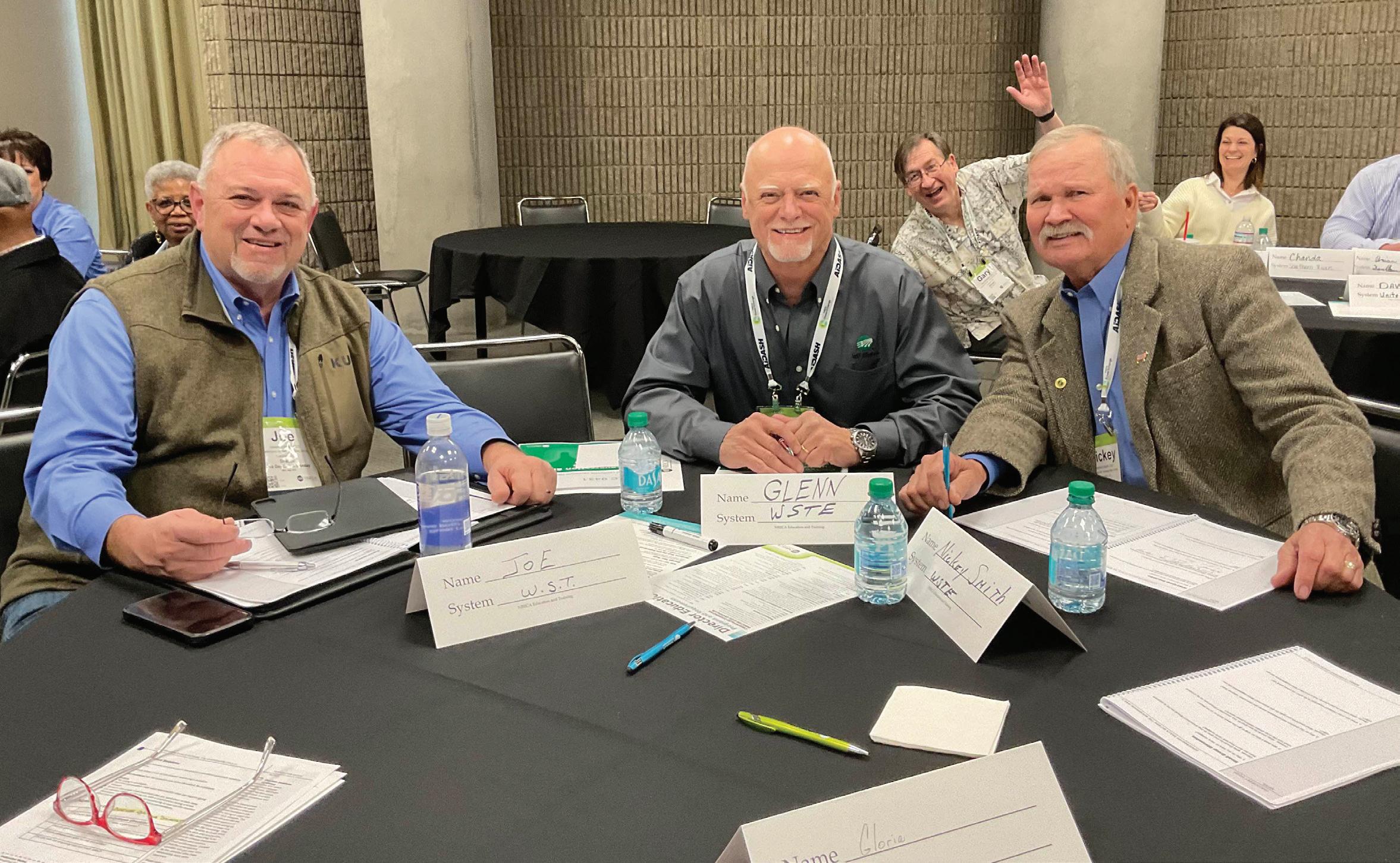
Louisiana Electric Cooperatives Attend NRECA’s PowerXChange

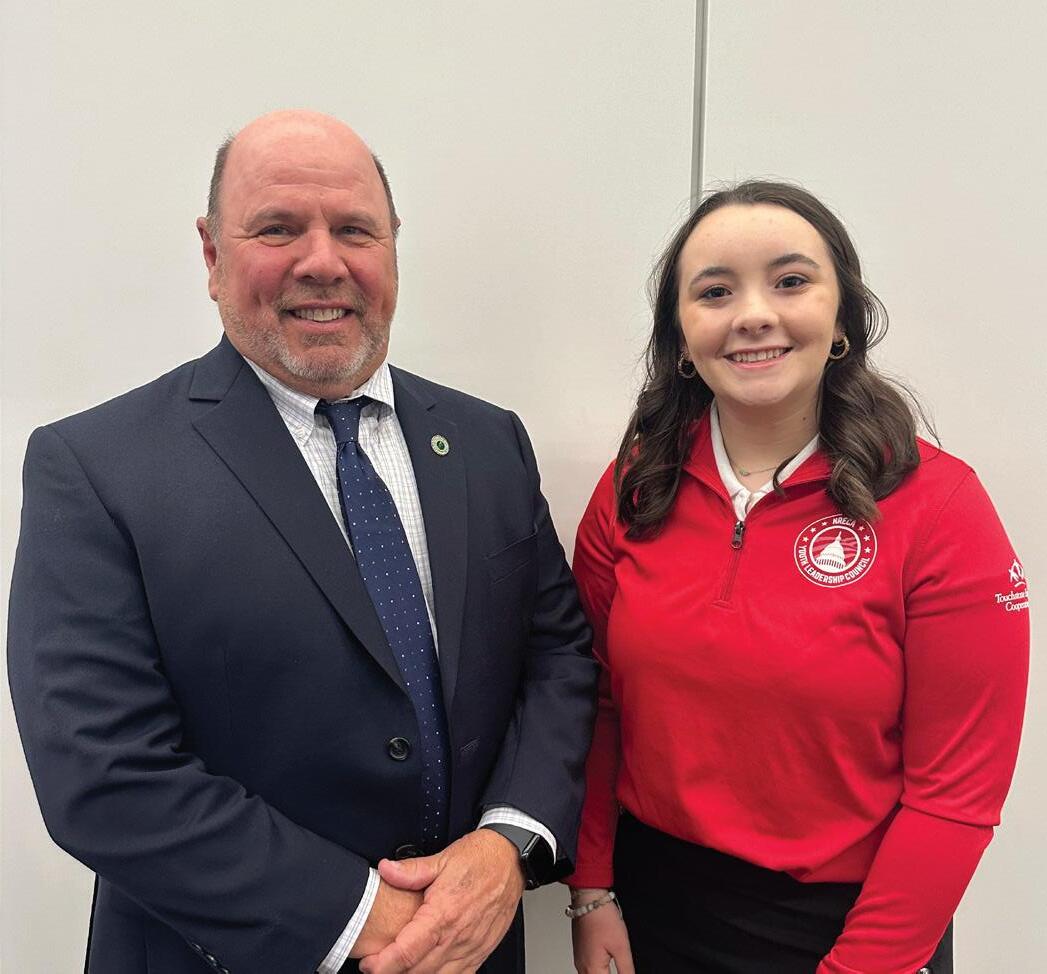
Washington–St. Tammany Electric Cooperative board members, from left, Joe Jarrell, Glenn Magee and Nickey Smith attend board director training at the 2025 PowerXChange, the annual meeting of the National Rural Electric Cooperative Association. The conference brings together co-op leaders from across the country for educational sessions, networking and hands-on training.
Madelyn joins Louisiana NRECA Director Danny Berthelot, from DEMCO, at the 2025 PowerXChange.
Youth Leadership Council representative Madelyn Bailey, left, from Beauregard Electric Cooperative’s service territory, and Conley Bourgeois, Association of Louisiana Electric Cooperatives Youth Tour director, attend the 2025 PowerXChange in Atlanta.
Apply Today for a $500 Scholarship
Altec, Altec Truck, Altec Capital, Altec Sentry, AWP, JJ Kane, Linetec, Osmose and Tempest will award nine $500 scholarships for fall 2025 at the Association of Louisiana Electric Cooperatives Annual Meeting in July.
The following rules apply:
• Applicant must be the dependent of an ALEC member cooperative, including Beauregard Electric, Claiborne Electric, DEMCO, Jeff Davis Electric, Panola-Harrison Electric, South Louisiana Electric or WashingtonSt. Tammany Electric.
• Applicant must be a 2025 high school graduate.
• Applicant must provide verification of a minimum 2.0 GPA before scholarship is awarded.
• This is a one-time award.
• The award can be used for any college or university.
Application and current transcript must be postmarked by June 30, 2025. Altec is not responsible for mail delivery.
Mail to Ed Amedee, 1443 City Place, Gonzales, LA 70737.
Name of applicant: ______________________________________
Name of parent or guardian: ______________________________
Member co-op: _________________________________________
Address:
Phone number: ________________________________________
Name of high school: ____________________________________






Help Fund a Scholarship, Gain a Chance to Win!
Make a $1 donation to the Cooperative Youth Leadership Fund to enter a drawing for a new portable Blackstone grill.
Tickets are available at your electric cooperative.
The prize drawing is held in July at the Association of Louisiana Electric Cooperatives Annual Meeting banquet in Baton Rouge.
You do not need to be present to win. The winner is contacted by phone.








Welcome, Jared!
We are thrilled to welcome Jared Lebo to the cooperative family team! Jared joined us March 10, as our new GIS technician. He is a graduate of Southeastern University and a resident of Mt. Hermon. When Jared isn’t working, you can find him enjoying his favorite pastime: fishing. Congratulations, Jared!

“My uncle Jake is my hero. He is the best uncle in the entire world. He climbs really high with knives on the back of his boots. He takes me turkey hunting all the time. He is a really cool linemen.”
RAWLS THOMAS
































Barataria Bonanza


South Louisiana estuaries offer great angling variety




Story and photos
John N. Felsher



by




Capped by Lake Salvador to the north and Barataria Bay to the south, the Barataria Estuary offers anglers some of the best inshore saltwater fishing action in North America in a beautiful wilderness setting close to Louisiana’s largest city.
“We’re about 19 miles south of New Orleans,” says Theophile Bourgeois IV, of Bourgeois Fishing Charters in the town of Barataria. “We can see New Orleans across the marshes when we’re fishing. Just outside that metropolitan area, we have such a lush natural environment with so many fish, bird and animal species.”

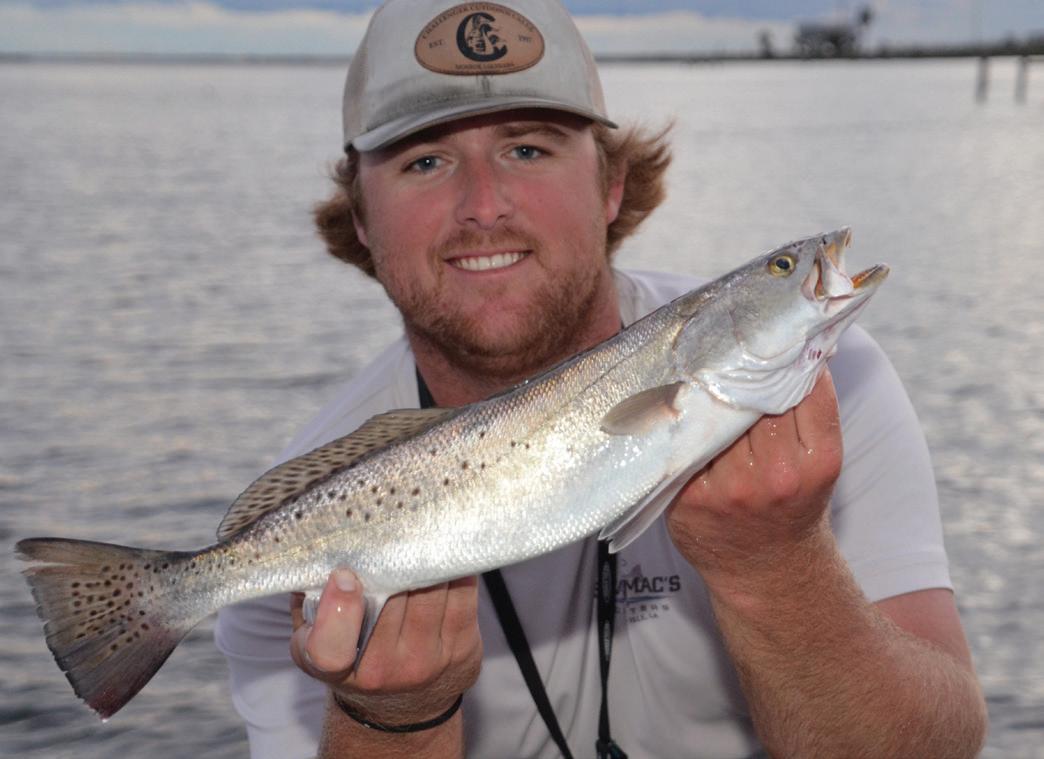

As the son and namesake of a late, and legendary, fishing guide, Theophile grew up fishing these rich waters. Between Lake Salvador and Barataria Bay, anglers can fish unlimited ponds, bayous and other waters for various species. These marshes create ideal nursery grounds for many species.
Redfish
At times, anglers spot huge schools of bull redfish ravaging mullets and other baitfish in Lake Salvador, Barataria Bay and other places. In the marsh ponds, the spot-tailed marauders habitually get in water so shallow that their coppery backs protrude above the surface.


“All the ponds and bayous north of Barataria Bay hold good redfish numbers,” Theophile says. “Some better places include the Bayou Dupont area, Airplane Bay, Round Lake and Lake Laurier. We look for good, clean moving water and baitfish. On a falling tide, I like to fish where a (trench) drains the marshy ponds. I also like to work the grassy points.”
Anglers can catch redfish many ways. Many dangle live shrimp or soft-plastic shrimp lures under popping corks. Spoons, jigheads tipped with plastic trailers and spinnerbaits also work. When redfish turn more aggressive, nothing excites anglers like big redfish erupting on a topwater bait.
“Sometimes we spank the redfish on gold spoons,” Theophile says. “Silver or bronze colors also work. I always keep a topwater bait tied to one line. There’s nothing better than watching a big redfish explode on a topwater bait.”



ABOVE: Theophile Bourgeois and Bobby Beroular, a guide for Bourgeois Fishing Charters, show off a pair of redfish they caught while fishing in the marshes near Lafitte.
BELOW: Cole McCarty, with Sea Mac’s Charters in Grand Isle, shows off a speckled trout he caught in the Barataria Estuary.

Speckled Trout
More known for producing great numbers than giant speckled trout, the Barataria area does hold some big fish. Most trout weigh 1 to 3 pounds, but anglers occasionally catch bigger ones. Larger trout generally come from bigger bays and lakes closer to the gulf.
Although anglers can catch speckled trout, redfish and flounder in many places on the same baits, specks typically prefer deeper waters. Look for them in the passes, larger lakes and deeper bayous—particularly where two streams intersect or a bayou connects with a lake. Trout hunt shrimp and baitfish in open waters, so lures that imitate natural prey work best.

“A popping cork with soft plastics is hard to beat for catching trout at any time of year,” says Mike Helmer with Capt. Phil Robichaux’s Fishing Charters in Lafitte. “We also fish soft plastics on the bottom.”
Flounder
Few anglers intentionally fish for flounder, but nobody wants to throw back one of the tastiest fish anywhere. Twice each year, flounder migrate into and out of the estuaries, but some stay in inshore waters all year long. Flounder generally leave the marshes, bays and estuaries in late October or November when water temperatures chill. After spawning and spending the winter in the gulf, flatties head inshore in March or April.

congregate in deeper water with shell or hard bottoms.”
Although challenging to clean, sheepshead taste delicious. Sheepshead eat barnacles, crabs, shrimp and other crustaceans. They stay near hard structures with barnacles, such as pilings and reefs. Sheepshead put up a tremendous fight. They hunker down and dare anglers to pull them to the surface.
“At the right time, we can catch as many sheepshead as we as feel like fighting in some of the deeper channels lined with rocks,” Mike says. “They are a lot of fun to catch.”

Flounder normally hit natural baits, like minnows or shrimp, but the surprisingly agile and aggressive fish do strike soft plastics, spoons, spinnerbaits and other lures. Drifting a live shrimp, minnow or shrimp imitation under a popping cork along a weedy shoreline works effectively. Another technique is to hook a live minnow to a jighead and drag it along the bottom. The squirming minnow attracts a flounder’s attention.
Other Species
Besides redfish, speckled trout and flounder, Barataria anglers might also catch sheepshead, black drum, white trout and other species. On any given day, anglers may land seven or more different fish species in the same general area on the same baits, particularly when fishing with live or dead shrimp.


Whether loading a boat with speckled trout or battling monster drum and redfish, anglers can usually find something biting most days in this fertile delta wetland wilderness ecosystem surrounded by abundant wildlife.
To book a trip, call Bourgeois Fishing Charters at 504-341-5614 or visit www.neworleansfishing.com. For Capt. Phil Robichaux’s Fishing Charters, call 504-689-2006 or visit fishwithphil.com. For area information, contact Visit Jefferson Parish. Call 504-203-6740 or 877-572-7474. Online, see www.visitjeffersonparish.com.

“We catch drum when fishing for redfish with shrimp,” Theophile says. “With shrimp, we catch a lot of different species.”
Black drum can grow huge and put up a tremendous fight. The biggest sport fish in Louisiana inland waters, a black drum can exceed 70 pounds, providing outstanding action on light tackle. Smaller drum make excellent eating.
A black drum might hit an occasional soft-plastic lure but generally prefer fresh meat such as shrimp or baitfish. However, nothing appeals to a drum or a big redfish more than a crab. Some people use small live crabs hooked through the back near the rounded “swimmer” fins. For larger drum and redfish, remove the top shell of a crab and break it into two halves. The succulent juices oozing from a half crab drive drum and redfish wild.
“We catch some big black drum in the deeper holes on cracked crabs with Carolina rigs,” Mike says. “They usually

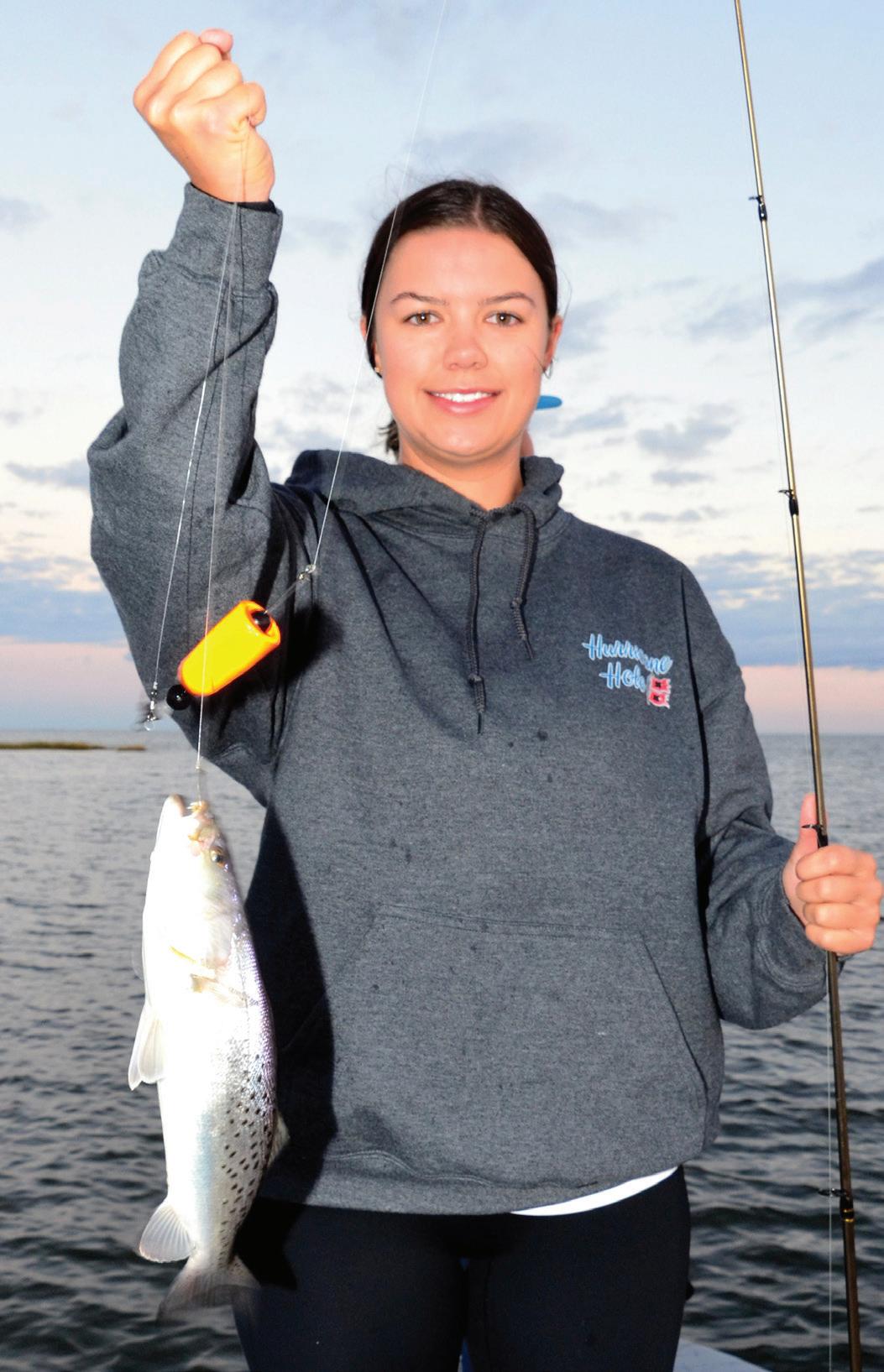


Rehgann Gafford shows off a speckled trout she caught while fishing with Sea Mac’s Charters in Barataria Bay, north of Grand Isle.
A Summer
Take a family-friendly day
By Cheré Coen
trip across the Pelican StatePlayground
Summertime isn’t so easy when tiny feet are running around looking for fun things to do. Don’t worry; Louisiana offers plenty of day-trip destinations and attractions. Many are free.
Jean Lafitte National Historical Park and Preserve

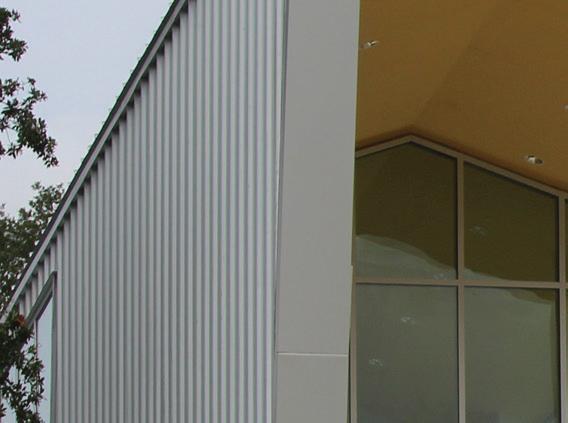

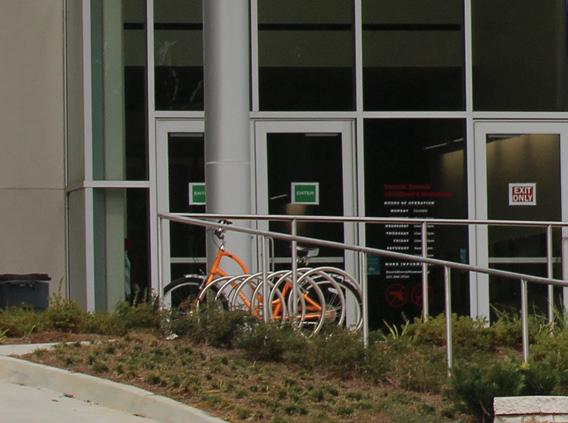





A local National Park Service site, Jean Lafitte National Historical Park and Preserve has five Louisiana units: Lafayette, Eunice, Thibodaux, the Chalmette Battlefield and the French Quarter Visitor Center.
Hours vary—Eunice is only open Thursdays through Saturdays, for instance—but entrance to all parks is free. In addition to learning about the people who settled South Louisiana, visitors may enjoy special events, such as boat rides at the Wetlands Acadian Cultural Center in Thibodaux.
Children’s Museums


Louisiana is home to several children’s museums, including the Children’s Museum of Acadiana in downtown Lafayette and the Louisiana Children’s Museum in New Orleans’ City Park.
A few years ago, Baton Rouge opened the Knock Knock Children’s Museum,



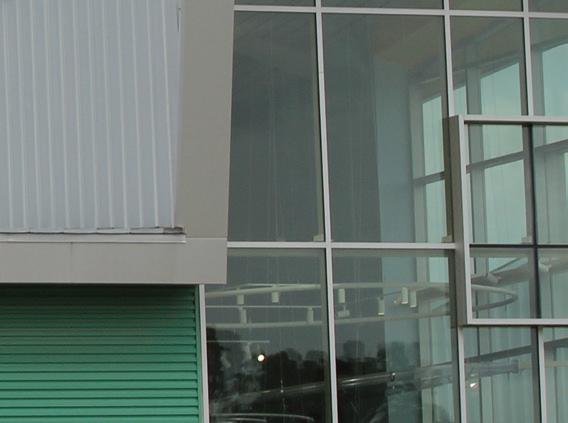



The Knock Knock Children’s Museum in Baton Rouge offers numerous exhibits, interactive play and educational programming. PHOTO BY CHERÉ COEN
Playground
a 26,000-square-foot facility inside the Baton Rouge Recreation and Environmental Commission’s City-Brooks Community Park. The museum features 18 learning stations, including a two-story climbing structure, interactive play areas and education programming.
In Shreveport, Sci-Port Discovery Center combines science and entertainment in its massive museum. It includes a planetarium, an IMAX Dome Theater, more than 200 hands-on exhibits and special events.
New this year is the Children’s Museum of Southwest Louisiana at Port Wonder, on North Lakeshore Drive on the Lake Charles lakefront, right off Interstate 10. Four galleries filled with interactive exhibits keep children occupied. The museum hosts special events throughout the year, and party rooms are available.
Next door is the Louisiana Department of Wildlife and Fisheries’ new Nature and Science Center, with freshwater and saltwater aquariums.
Visit a Park
There are 21 state parks within Louisiana. Amenities range from lakefront cabins and a beach at Fontainebleau State Park on Lake Pontchartrain in Mandeville to Civil War history at Port Hudson
near Baton Rouge and ancient Native American mounds at Poverty Point World Heritage Site.
State parks visitors can bathe in the great outdoors at Toledo Bend in the South’s largest manmade lake, stargaze while enjoying the renovated cabins at Sam Houston Jones State Park north of Lake Charles and learn about the state’s unique habitats at the Louisiana State Arboretum.


The Children’s Museum of Southwest Louisiana recently opened at Port Wonder on Lake Charles. PHOTO COURTESY OF PORT WONDER
Fontainebleau State Park on Lake Pontchartrain in Mandeville provides many ways for visitors to enjoy the water. PHOTO BY CHERÉ COEN
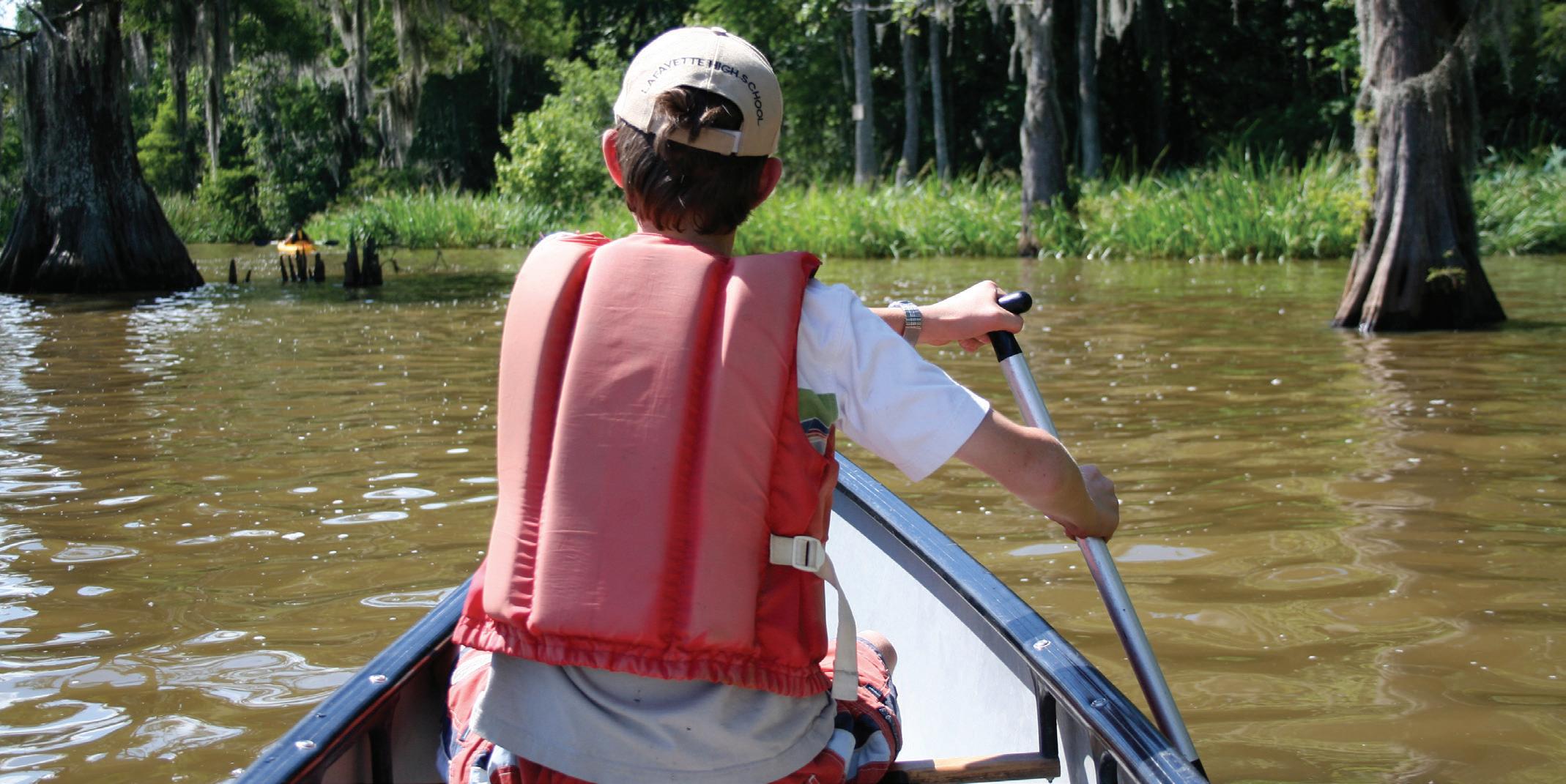
Many cities offer their own ways to get outdoors. In Baton Rouge, for instance, there are more than 170 parks inside the BREC system. Daily programming includes classes, special events, a state-of-the-art observatory, a zoo and the Blue Bonnet Swamp Nature Center. BREC is one of the few parks and recreation agencies in the country to win multiple national awards for excellence.
Cool Off
One way to beat the heat this summer is by plunging into cool waters. There are many splash pads to choose from, including those at Parc San Souci in Lafayette, Palmetto Island State Park south of Abbeville, the Splash Park in Sulphur and six locations around the Shreveport-Bossier area. Most are open during daylight hours from Memorial Day or earlier until midfall.
If you’re really into water, Blue Bayou Water Park outside Baton Rouge provides H2O in a variety of ways, from heart-racing rides to lazy rivers and wave pools.
Get Artsy
Artspace in Shreveport wears many hats. It’s an art exhibition space, for sure—don’t miss the Critical Mass annual invitational exhibition for artists who live in the nine parishes of Northwest Louisiana. But Artspace mostly provides a space for the public to experience art in a variety of ways, from classes and workshops to interactive events.
Paddles Up
Look around Louisiana, and it’s easy to see why there are so many canoe and kayak rentals. The state has massive bodies of water,

from the Atchafalaya Basin—the nation’s largest river swamp—to Lake Pontchartrain, where the causeway is the longest continuous span over water in the world. Then, there are bayous and rivers galore.
A few places to rent canoes or kayaks are Pack and Paddle and Wanderlust Rentals in Lafayette, Lake Area Adventures in Lake Charles, Wildwood Resort on Toledo Bend and McGee’s in Henderson. If paddling is too much work, several outfitters rent tubes for a slow float on the Bogue Chitto River north of Lake Pontchartrain.
Go Pickin’
Strawberry picking at Mrs. Heather’s on Highway 43 in Albany runs through May 11. Owner Heather Hughes provides buckets and sets vistors free to pick. She hosts special events as well.
“We have many activities for kids, including a zip line, tunnel slides, a corn box, a jumping pillow, a swing set, a merry-goround, face painting and milking the cows,” Heather says.
Louisiana offers numerous ways to explore the state’s many bayous and streams. PHOTO BY CHERÉ COEN BELOW: A rare albino bottlenose dolphin with a pink hue, nicknamed “Pinky,” is often spotted along the Creole Nature Trail. PHOTO COURTESY OF ERIK RUE
Find Pinky
Folks enjoying the Creole Nature Trail south of Interstate 10 in the state’s southwest corner sometimes come upon a startling sight— a rare albino bottlenose dolphin with a pink hue. Nicknamed “Pinky,” this rosy-hued dolphin has become so popular there’s even a Facebook page dedicated to sightings. The best place to spot Pinky and other dolphins is along the Calcasieu Ship Channel and surrounding waterways south of Lake Charles.
Road Trip
There’s nothing like a road trip, and Louisiana offers 19 scenic drives for those who don’t want to plan an itinerary.
In the northwest corner, the Boom or Bust National Scenic Byway stretches 136 miles through four parishes to spotlight the area’s history, parks, fields of blooming sunflowers, back-road eats and more.
The Creole Nature Trail All-American Road forms a massive loop from Interstate 10, east of Lake Charles, through prairies, bayous, marshlands, 26 miles of Gulf Coast beaches before returning north to Sulphur. The Southern Swamp Byway winds through Ascension Parish and Ponchatoula, then down toward Lake Pontchartrain and ending at LaPlace and its famous andouille.
For more on Louisiana’s byways, visit explorelouisiana.com/ articles/take-scenic-route-louisianas-byways.
Visit a Museum
When temps begin to rise, a cool museum visit may be in order. The Beauregard Museum in DeRidder tells the history of the region, with Native American artifacts and items from the sawmill days. It also explains the region’s development with the arrival of trains. The museum is in a former Kansas City Southern passenger train depot, and children love exploring the caboose in the courtyard.
In Crowley, the three-story Crowley Motor Co. & Ford Building— built in 1920—houses several museums under one roof: the Rice Interpretive Center, the History of Crowley, the J.D. Miller Music Recording Studio and the Ford Automotive Museum.

For those who prefer oddities, Abita Mystery House in downtown Abita Springs fills the former gas station, barn and other buildings with a collection of dioramas, arcade games, paintby-number scenes, folk art objects and Darryl the Dogigator, who is half dog and half gator.
Find Dinosaurs
Who knew there were dinosaurs outside the Atchafalaya Basin in Henderson? We’re talking dinos of all kinds, including five animatronic beasts. The dozens of dinosaurs of Prehistoric Park that’s adjacent to Camp Margaritaville RV Resort won’t eat you, thank goodness, but they are life-sized replicas.
Stroll through 12 acres to spot these ancient creatures, then enjoy the other attractions, such as fossil digs and gem mining. n

A Few Festivals to Consider Art for Animals Festivals, Baton Rouge Zoo: Through May 3
Gonzales Jambalaya Festival: May 23-25, jambalayafestival.net
Gheens Bon Mangé Festival: June 6-8, gheensbonmange.weebly.com/festival.html
Holly Beach Crab Festival, Cameron: June 13-15, www.visitlakecharles.org/event/holly-beach-crabfestival/46592
St. Landry BBQ Festival, Yambilee Grounds in Opelousas: June 20-22, stlandrybbqfestival.com
Erath Fourth of July Festival: June 30-July 4, erath4.com
Life-size replicas of dinosaurs dot 12 acres of Prehistoric Park in Henderson.
Wildlife such as deer and migratory birds may be found at Sam Houston Jones State Park north of Lake Charles. PHOTOS BY CHERÉ COEN















DO MORE

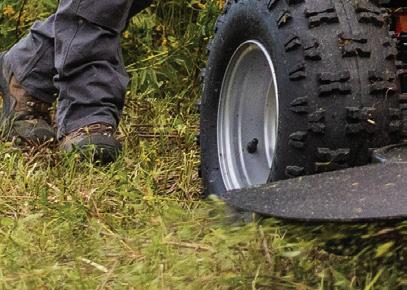





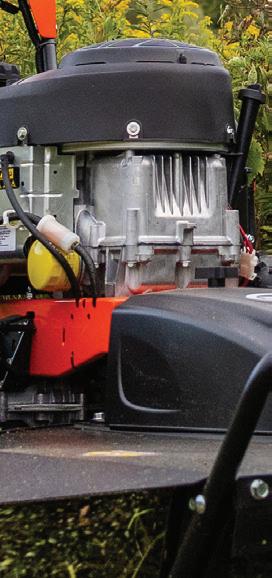


WITH YOUR DR® FIELD & BRUSH MOWER



















Mower gives you MORE


POWER – to mow through anything with up to 2X more than the competition. MANEUVERABILITY

– thanks to power steering and hydrostatic drive options.
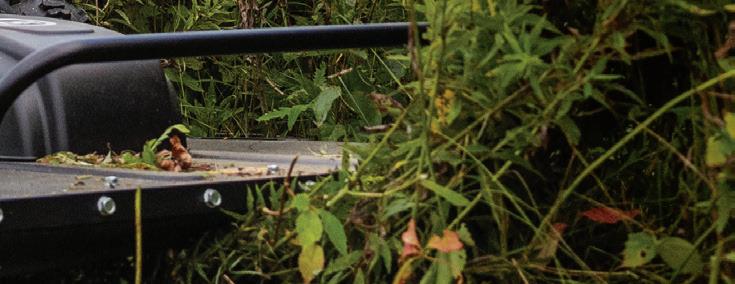

FEATURES
– including easy to use controls and available attachments.



– Commercial, Electric, Walk-





























CHOICE and Tow-Behind models available. Scan






















































Trip of a Lifetime
Two Students Selected to Attend
Lylah Crain and Holly Melton will represent Washington-St. Tammany Electric Cooperative as part of the 2025 Washington, D.C., Youth Tour.
The Youth Tour program, a trip of a lifetime, is administered by the Association of Louisiana Electric Cooperatives. This exciting opportunity is June 14-21, bringing together more than 1,500 cooperative students from across the country.
The selected students will embark on their journey June 14, joining peers from around the state. During the
the
2025 Youth Tour
trip, they will have the chance to meet members of the Louisiana congressional delegation on Capitol Hill, tour significant monuments and museums on the National Mall, and participate in comprehensive youth leadership training. (Account No. 50110405)
The trip promises to be a transformative experience, offering students a unique blend of educational and leadership opportunities. Congratulations to Lylah and Holly for their selection and best wishes for their upcoming adventure.
Lylah Crain Holly Melton
Louisiana Co-ops Mourn
Buck Theriot Sr.


Louisiana cooperatives are mourning the loss of longtime co-op leader and advocate Hayward “Buck” Theriot Sr., 79. A native and resident of Houma, Buck died Feb. 17 of Parkinson’s disease and Lewy body dementia. Best known for his generous spirit and infectious Cajun humor, Buck dedicated his life to serving others through his work and passion for giving.
He is survived by his wife of 30 years, Earline M. Theriot; sons John Theriot (Nicole) and Hayward Theriot Jr. (Paul); daughter, Melissa Davis; stepchildren Bobette Talbot (Mark), Leigh Champagne (James), Marty Domangue (Danae) and Kyle Domangue (Julie); grandchildren Morgan Arceneaux, Skylar Davis and Baely Davis; stepgrandchildren Therese Talbot, Everette Talbot, Kayleigh Gordon, Kandice Bergeron, Kirstie Cryer, Brady Domangue, Bryce Domangue, Olivia Rasberry, Emma Domangue, Kylie Domangue, Gracie Gautreaux, Carlie Christ and Elle Christ; three great-granddaughters and 18 stepgreat-grandchildren, with two soon to be born; and sisters Jan Vice (Cary), Debbie Doiron (Jimmy) and Elaine Monnier (Harold).
Buck was preceded in death by his parents, Oscar and Eula Toups Theriot; grandson Wade Theriot; and son-in-law Todd Davis.
Buck served in the Army National Guard for seven years and five months before joining South Louisiana Electric Cooperative Association in 1964. Throughout the course of his 48-year career, he rose to superintendent at SLECA, retiring in 2012. Despite the long tenure, a single life-altering incident in 1990 sparked his most enduring legacy. After a lineworker friend survived a severe electrical burn, Buck realized lineworkers needed more rigorous safety training. Upon accepting a job as the Louisiana Association of Electrical Cooperatives’ state safety and training director, he wrote a four-year, eight-level training manual that integrated both hands-on instruction and safety. By the time he retired, more than 300 linemen had completed this program.
Buck’s leadership extended beyond Louisiana, as he served as chairman of the Southern Area Instructors Association and later the National Association of Utility Safety and Training



Hayward “Buck” Theriot Sr.
Professionals. He traveled widely to teach these courses, often accompanied by Earline. He broke the ice at each session with a Cajun story—quickly becoming legendary for his humor and ability to make tough, hardworking lineworkers feel at ease.
His kindness and generosity stretched well beyond the classroom. Known to cook jambalaya in large, black iron kettles, Buck often led fundraisers for churches and local causes. Even after the heartbreak of losing his grandson Wade to Type 1 diabetes, he organized cooking events that raised thousands of dollars for the Juvenile Diabetes Research Foundation. Whether he was serving gumbo for 50 people at a holiday gathering or dishing it out for church fundraisers, Buck always did it with a smile and a giving heart.
Louisiana’s cooperative community will remember Buck as a generous spirit and a champion of safety whose Cajun charm, culinary talents and devotion improved countless lives and probably saved a few. He was the kind of man who gave tirelessly and asked for nothing in return. He leaves behind a legacy of mentorship, warmth and dedication that will guide those who knew him, as well as future generations of Louisiana lineworkers.
Teaching Energy Efficiency
Electronic and mobile devices, TVs, computers and gaming stations have become ubiquitous fixtures in our homes, particularly those with children. Consumer electronics coupled with the proliferation of smart home appliances, technology and electric vehicles have slowly but steadily changed our homes and lifestyles.
This ever-connected world is the modern environment in which children are growing up. With lifestyles increasingly reliant on technology and in turn, energy consumption, teaching the younger generation to save energy is an important life lesson.
The Why
Before parents can teach their children how to save energy, they must first answer the question, “What’s in it for me?”
As most parents can attest, convincing children to care about energy efficiency is a hard sell. Parents need to explain why it’s important to save energy and how it benefits the child—otherwise they do not understand the need to change their habits and are less motivated to do so. In the simplest terms, less money spent on an electric bill can mean more money used for fun activities, which is something children can relate to.
Less tangible, but just as important, using less energy means running your home more efficiently, conserving natural resources and helping the environment.
Learning by Doing
Because saving energy is an abstract concept for children, be specific about energy efficiency actions and set an example.
We know children learn by observing what their parents do. Even if they don’t say anything, children are processing your actions. When you turn off the lights when leaving a room or unplug the phone charger once the device is fully charged, they notice.
Learning about energy efficiency doesn’t
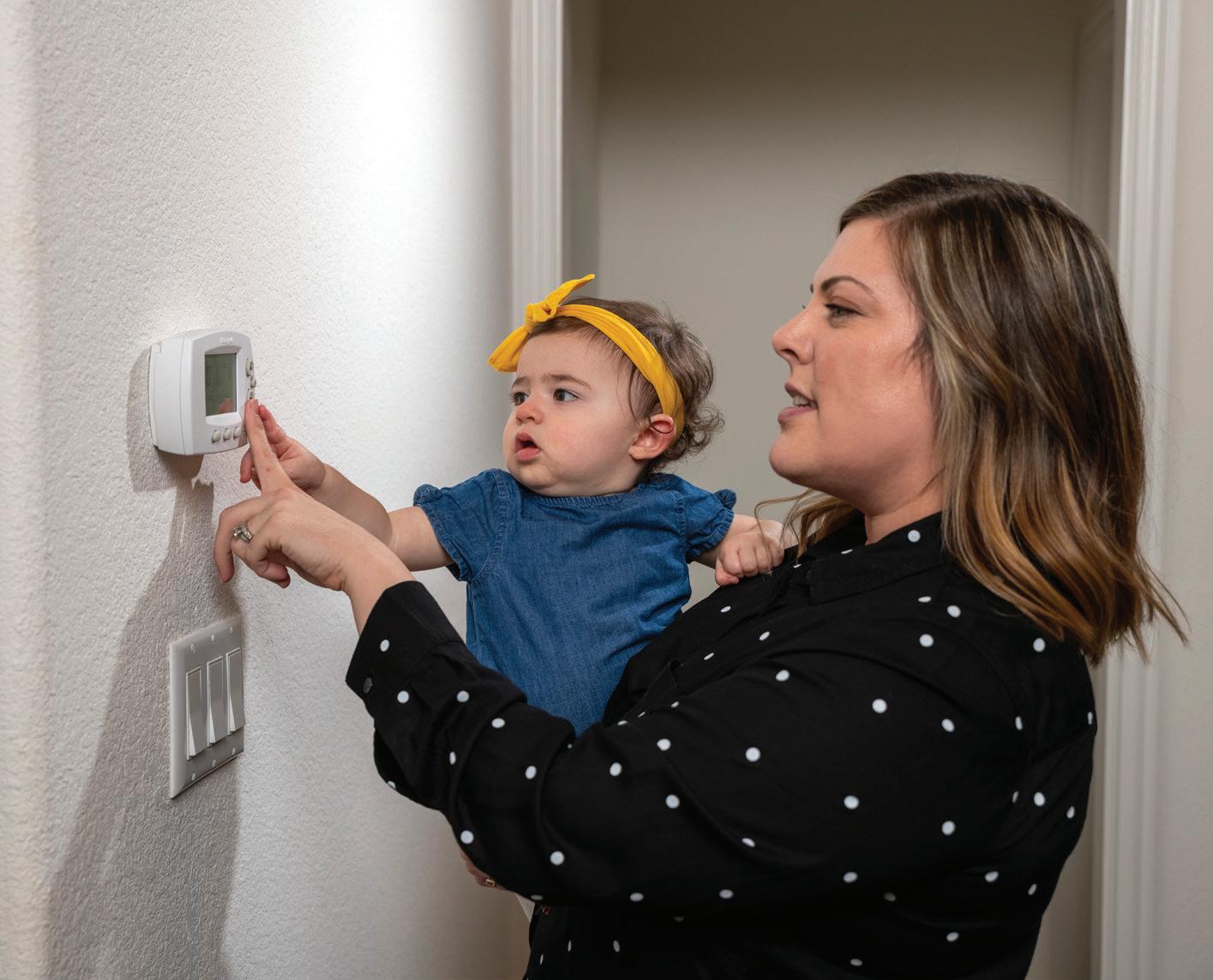
have to be a boring lecture. Make it fun for greater impact.
For younger children, turn energy efficiency into a treasure hunt to locate all the things in your home that use electricity. Depending on the age of the children, challenge them to count and group the items into categories: electronics, appliances, lights, etc. If age appropriate, have them create a list. Ask which gadgets and appliances could be turned off or unplugged to save power every day.
For older children, show them how to program smart thermostats and appliances. Shop with them for LED lights and discuss Energy Star-rated appliances. Show them the electric bill so they can see the costs, energy use and how their actions impact the bill.
Children can learn a few simple energysaving habits that can last a lifetime:
• Turn off lights, devices, computers and video game consoles when not in use.
• Open blinds and curtains during winter days to let warm sunlight in, and close them during summer days to keep your home cooler.
• If your children are old enough to run the dishwasher or wash their own clothes, teach them to run these appliances only with a full load and during off-peak energy hours.
Rewards
Offer rewards for agreed-upon milestones. Rewards provide positive reinforcement on energy-saving actions.
The idea is to create a habit of being energy efficient. For parents, this could mean less nagging about turning off the lights.
Teaching your children about saving energy is not only a creative way to spend time with them; it helps your home be more energy efficient and can instill good habits that benefit your child as they make their way into adulthood. n
Teaching your children the important lesson of energy efficiency can start at an early age.



The Smile Says It all


PHOTOS COURTESY OF DAVID THOMAS
Ski-Dawgs offers
the joy of waterskiing to those who may otherwise not have the opportunity
By Mimi Greenwood Knight
David Thomas knew he was badly hurt.
It was 1985 and David was 15 years old when the homemade trapeze he constructed gave way, throwing him 15 feet where he landed on his head and lay in a crumpled heap. He was rushed to the local hospital then quickly transported to Ochsner Medical Center in New Orleans. After emergency surgery, David’s parents received the devastating news that their son had broken his neck and would be a quadriplegic for the rest of his life.
As David adjusted to life in a wheelchair over the next few years, there were many things he missed, including carefree hours spent at the end of a ski rope, the wind in his hair and the spray on his face. Forty years later, David has not only realized the joy of waterskiing again but—with the help of sponsors, donors and volunteers—is offering that experience to others with disabilities.
He’s able to offer this experience through a nonprofit organization called Ski-Dawgs Adaptive Water Skiing. Every summer since 2018, Ski-Dawgs has offered the joy of waterskiing in a safe, controlled manner to those who might otherwise never have the opportunity.
Participants may have mobility limitations or live with conditions such as Down syndrome, autism or traumatic brain injury. Skiers take to the water on a specially constructed ski. The ski is made of three skis—one in the middle that’s similar to a surfboard, with outriggers on either side for stability, and a seat fashioned on top.
Participants water-ski with volunteers immediately behind them on personal watercraft to assure their safety. More volunteers are waiting at the dock to receive them upon their return..
If a Ski-Dawg participant is still nervous about mounting the adaptive ski, there are other options. They can enjoy tubing behind the boat in a tube that’s large enough for them, a family member and a volunteer.
The smiles on their faces say it all.
“Some participants are apprehensive at first, but they come back with a smile they can’t get rid of the rest of the day,” David says.
And as much as the experience means to the skiers, it means even more to their families who watch their loved ones enjoy something they never thought they could.
“It’s something they can look forward to all year,” Co-Director Tracy Galloway says. “It’s a day they’ll never forget, and we’re so grateful to the volunteers and donors who allow us to give it to them. This is absolutely a team effort, and so many people make it possible.”
David began Ski-Dawgs with his college friend, Griff Knoop. However, as life circumstances demanded more of Griff’s time, longtime volunteer Tracy and her brother, Jamie, joined them to round out the Ski-Dawgs board of directors.
As the only adaptive waterskiing program in Louisiana, they schedule four ski days each summer—completely free of charge—to participants and their families.
“When people ask what it costs, Jamie tells them it’s gonna cost
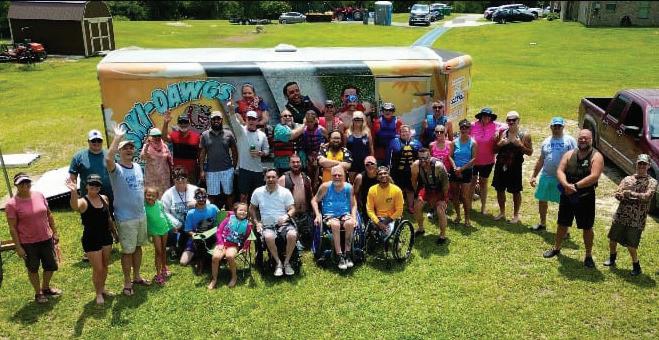
them a smile,” Tracy says.
David and Griff came up with the name Ski-Dawgs when they visited their alma mater, Louisiana Tech University, and snapped a picture side by side under a mural of Tech’s beloved bulldog mascot.
“We decided to call it Ski-Dawgs in honor of the LA Tech bulldog,” David says. “Then we held a contest to come up with the name of our own mascot and the winning entry was Buoy.”
Ski-Dawgs can accommodate 20 to 30 skiers in each daylong session. Family members are encouraged to make a day of it with lunch and fellowship provided on the beach with the adaptive skiers at the center of the activities.
Stacy Bordelon, another longtime volunteer, is a certified boat driver. She not only supplies the boat and volunteers her time driving it, but she and her husband, Gus, offer their home on Pearl River Navigational Canal for the festivities.
It takes 20-plus volunteers to pull off each ski day, and David says they couldn’t do it without them or their many sponsors and donors.
“Some volunteers have been with us since the beginning,” he says. “And they honestly have as much fun as the participants do.”
Sponsors include Coastal Environmental Services, the inclusion advocacy group Ainsley’s Angels, The Brain Injury Association of Louisiana and the Jennifer Palmer & Company Rehabilitation Center.
In addition to the sponsors, Ski-Dawgs recently received an $8,000 grant from the Christopher & Dana Reeve Foundation.
The 2025 ski dates are June 21, July 19, Aug. 16 and Sept. 20.
“We want as many adaptive skiers involved as possible,” David says. “You can sign up on our website or just show up on the day. Family is welcome, and we’ll serve lunch and provide drinks and snacks.”
If you want to donate, volunteer or sign up a skier, you can do so at SkiDawgs.com or find the organization on Facebook.
While you’re there, browse some of the pictures of adaptive skiers having the time of their lives on the water.
For more information, contact David at 985-516-8283 or email info@skidawgs.com.
Ski-Dawgs can accommodate 20 to 30 skiers in each daylong session. Family members are encouraged to make a day of it with lunch and fellowship provided on the beach with the adaptive skiers at the center of the activities. PHOTOS COURTESY OF DAVID THOMAS


























































































































































































Keep
Give your home a safety checkup to stay a step ahead of electrical fires
By David Herder
As the season shifts to summer, it’s the perfect time to prioritize safety, especially electrical safety, in your home.
According to the National Fire Protection Association, electrical failures and malfunctions contributed to 30,000 fires, 430 deaths, 1,070 injures and $1.3 billion in property damage every year between 2015 and 2019.

Give your home an electrical safety checkup to keep it how you like it—safe and free of electrical fire hazards.












































Cords
Cords and plugs are responsible for about 7% of deaths in home fires, despite only being involved in 1% of home fires, according to the NFPA. Extension cords are the most common cause of plug- or cord-related fires. Take these precautions with your cords:
• Check all cords for damage or fraying. These issues are fire and shock hazards.
• Don’t put weight on cords. Placing chairs or other heavy objects on cords can damage them.







































































































Your Cool
• Only use extension cords temporarily. If you need electrical access in a different spot, consider contacting a licensed electrician to install new outlets.
• Plug large appliances directly into outlets, never into extension cords.
• Wires inside of walls can be dangerous as well. Check for loose wall receptacles, wires or lighting fixtures, and listen for popping or sizzling sounds behind walls.
Outlets
Many electrical hazards are caused by faults— abnormal electric currents. Left untreated, these can cause shock and fire hazards. Using arc-fault and ground-fault circuit interrupter outlets can save lives.
Ground faults are where electricity has an abnormal path, creating a shock hazard. Make sure you have GFCI outlets anywhere that could become wet— including the bathroom, kitchen and any outdoor outlets.
Arcing faults often cause overheating in wires and electric equipment. Common culprits are pinched, damaged or overloaded wires. AFCIs shut off when they detect unwanted arcing. AFCIs are useful in all living areas.
Heating Equipment
Most electrical fire deaths occur in December and January, according to the United States Fire Administration. This is also the time of year when we use space heaters, wood stoves and other heating devices. Heating
devices can become dangerous when used improperly.
Keep these tips in mind when using heating devices:
• Keep anything that can burn at least 3 feet away from heating equipment, such as furnaces, space heaters, fireplaces or wood stoves.
• Only use products as intended. Space heaters are not for drying clothes, and the cooking stove is not a heater.
• Ensure all fuel-burning heating equipment is vented to the outdoors, and keep all intake and output vents clean and clear of debris.
• Always use a fireplace screen to prevent sparks from flying into the room.
• Never plug a space heater into an extension cord.
• Keep space heaters on level ground, away from areas where you may trip over it.
Generators
Many people use portable generators during outages. To properly use one:
• Let the generator run for a couple of minutes before plugging things in to prevent catastrophic surges. Similarly, plug things in one at a time, as each device requires a small surge to start up.
• Only plug generators into your home’s transfer switch or into a heavy duty extension cord rated for the weather conditions. Never plug generators into wall outlets—this can endanger lineworkers by backfeeding electricity onto distribution lines.
• Keep generators at least 20 feet from your home to prevent carbon monoxide poisoning.
New Batteries, New Fire Hazards
Many new devices enter our homes throughout the year, and that means new batteries to charge. Lithium-ion batteries are efficient and effective at powering phones, toys, e-bikes and more, but they can be fire hazards.
Damaged lithium-ion batteries can rapidly overheat and ignite. Whatever you’re plugging in, safe charging can prolong your battery life and prevent fire danger.
Stop using a battery if you notice any smell, change in color or shape, too much heat, leaking or odd noises.
Plug battery chargers directly into a wall outlet.
Don’t overload circuits. Batteries take in a lot of energy while charging. Make sure you don’t overload your home’s circuits by having too many items plugged in at once.
Charge in a flat, dry area, away from sunlight and doorways. Heat and water can create fire risks, and keeping batteries away from exits keeps emergency paths clear should a fire start.
Always buy batteries from known, quality sellers.
Stay near your batteries while they are charging, and consider unplugging them when they’ve reached 80% charge. Leaving batteries plugged in past full charge creates fire hazards. Also, lithium-ion batteries have the longest, most effective lifespan when they are kept between 30% and 80% charged.
Don’t Be a Victim of Phishing and Malware
In an era when cyber threats are everevolving, honing your skills to safeguard your digital presence is crucial. Email, once a simple way to stay in touch with friends and family, is now used for everything from shopping to banking. This creates increasing opportunities for scams, phishing attempts and malware to land in your inbox. Follow these tips and best practices to stay one step ahead of cyber pirates.
What is phishing?
Phishing is an attempt to collect your personal information, such as passwords and credit card numbers. These emails are usually disguised as being from a reputable company, such as your bank or a service provider you interact with regularly. Learn to spot a phishing attempt:
1. Scrutinize the sender’s address. One of the first signs of a potential scam is a suspicious sender address that looks legit at first glance. Check for misspelled domain names—often just a letter or two off—additional characters or other slight variations. For example, a phishing email purporting to come from your bank might use “yourbank-support@gmail.com” instead of the official domain.
2. Examine email content. Legitimate organizations prioritize professionalism in their customer-facing communications. Be wary of poorly written emails with grammatical errors, awkward sentence structure or an overemphasis on urgency. Phishing is all about catching you off guard and scaring you enough to get you to give up whatever information scammers are after. If you’re not expecting a link from a company, don’t click it.
3. Be cautious with personal information requests. Trustworthy entities seldom request sensitive information, such as passwords or credit card details, via email. Be skeptical of any email asking you to divulge personal or financial information.
4. Verify unexpected attachments. It is rare for a company to send you a link out
of the blue. If you’re being asked to click links, download files or open attachments, take the time to call the company and confirm they sent the link. More often than not, they did not send that email, and it is a scam.
5. When in doubt, throw it out. Much like the questionable leftovers in the back of the refrigerator, you’re not likely to miss a suspicious email once you delete it.
What is malware?
“Malware” is short for malicious software. It refers to any intrusive software developed to steal data, damage or destroy computer systems, or hijack a web browser to redirect the user to malicious sites.
Learn to avoid malware:
1. Keep your computer systems updated. We’ve all delayed downloading a software update. It can feel like a nuisance, but
many operating system updates and antivirus software include security updates and other patches that reduce vulnerabilities.
2. Use reliable security software. Invest in reputable antivirus and antimalware software to provide an extra layer of protection. Regularly scan your device for potential threats, and schedule automatic updates for real-time defense.
3. Steer clear of surprises. As with phishing attempts, malware hides in email attachments, links and popups. If you weren’t expecting it, don’t click it.
As your sense of cyber safety awareness evolves, you will develop a keen eye for spotting scams. By adopting these best practices and throwing in a little extra malware defense know-how, you can keep your personal data safe and surf the web with confidence. n
ADOBE STOCK ILLUSTRATION BY SAMMBY
